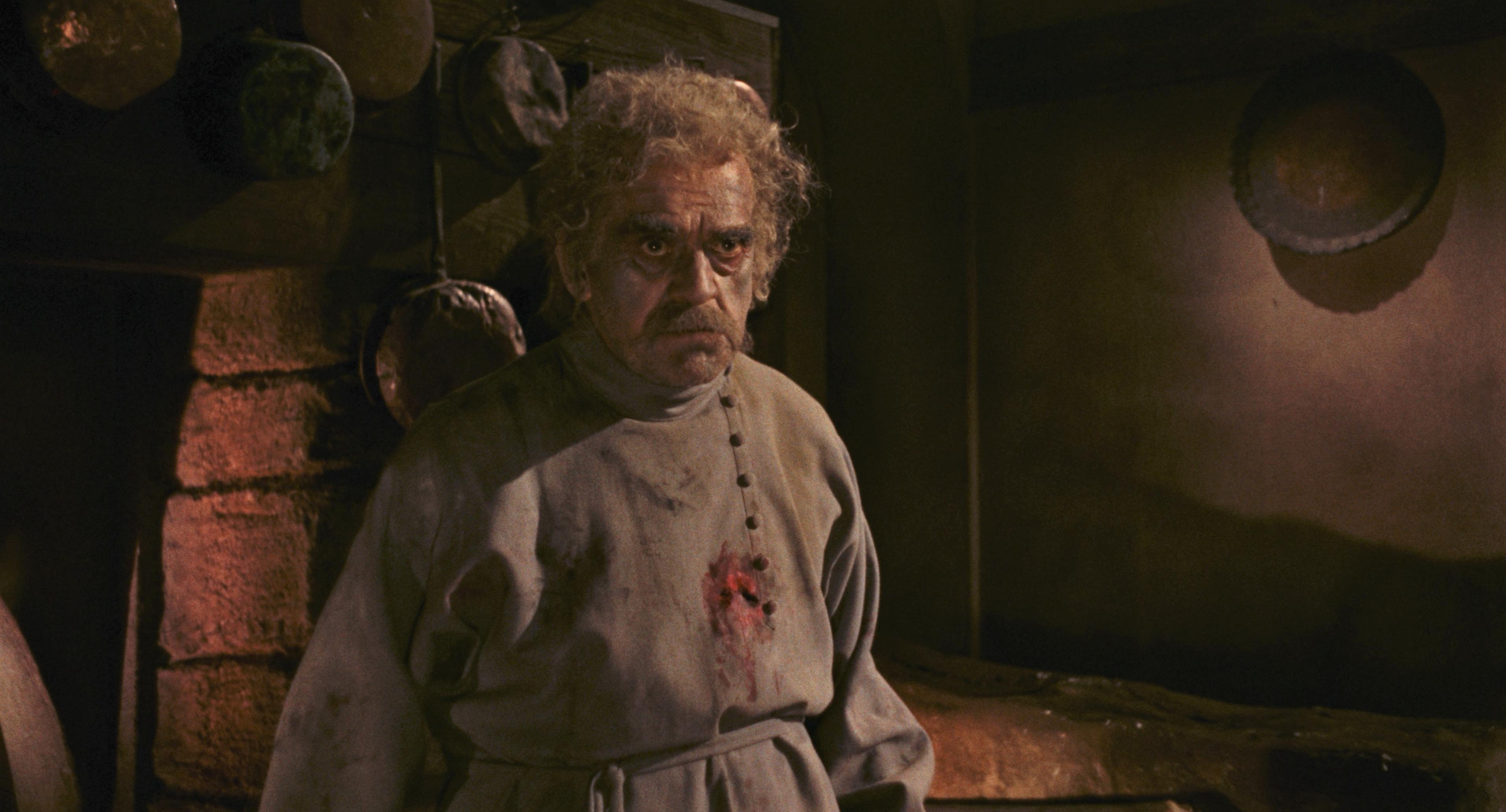
Black Sabbath, released in 1963, is a classic horror anthology film that has captivated audiences with its chilling stories and spine-tingling atmosphere. Directed by the legendary Italian filmmaker Mario Bava, this movie has become a cult favorite amongst horror enthusiasts for its unique blend of suspense, mystery, and supernatural elements. Featuring three terrifying tales, Black Sabbath showcases Bava’s mastery of visual storytelling and his ability to create an unsettling atmosphere that lingers long after the credits roll. From vampire seductresses to vengeful ghosts, this movie immerses viewers in a world of darkness and suspense. In this article, we will delve into the depths of Black Sabbath and uncover 37 fascinating facts about the film that will leave you with a newfound appreciation for this horror masterpiece.
Key Takeaways:
- Black Sabbath, a classic horror anthology film, features three chilling stories and a haunting musical score. Its timeless scares and influential impact continue to captivate audiences and inspire modern horror cinema.
- With Boris Karloff’s iconic presence and Mario Bava’s visionary direction, Black Sabbath remains a must-watch for horror fans. Its diverse storytelling, eerie visuals, and lasting legacy make it an unforgettable cinematic experience.
The movie Black Sabbath was released in 1963 and is considered one of the greatest horror anthology films of all time.
Black Sabbath, directed by Mario Bava, consists of three chilling stories: “The Telephone,” “The Wurdalak,” and “The Drop of Water.” Each story explores different themes of fear and the supernatural.
Boris Karloff, a horror cinema legend, stars in the film and also serves as the host and narrator.
Karloff’s iconic presence adds an extra layer of fright to the movie, drawing in audiences with his commanding and eerie performance.
The film is titled “Black Sabbath” in the English version, but in the original Italian release, it was called “I tre volti della paura” meaning “The Three Faces of Fear.”
This change in title adds to the mystique and allure of the film, intriguing audiences with its enigmatic nature.
The musical score for Black Sabbath was composed by Les Baxter and features a hauntingly beautiful mix of classical and contemporary sounds.
The score perfectly complements the suspenseful and atmospheric scenes, enhancing the overall viewing experience for audiences.
Black Sabbath was influenced by the works of Edgar Allan Poe.
The movie draws inspiration from Poe’s macabre tales, capturing the essence of terror and psychological unease that the author is renowned for.
The film’s cinematography is exceptional, with Mario Bava employing innovative camera techniques and lighting to create a haunting visual atmosphere.
Bava’s artistic vision is evident throughout the film, immersing viewers in a world of darkness and dread.
Black Sabbath was a critical and commercial success, gaining recognition for its unique storytelling approach and its ability to instill genuine fear in its audience.
It is regarded as a classic within the horror genre and has continued to captivate audiences over the years.
The movie explores various horror subgenres, including psychological horror, supernatural horror, and vampire folklore.
Each story presents its own distinct style and atmosphere, catering to different preferences within the horror genre.
Despite being released in the 1960s, Black Sabbath’s themes and scares remain relevant and effective, proving the timeless nature of true horror.
The film’s ability to evoke fear and unsettle viewers is a testament to its enduring appeal.
Black Sabbath inspired several future horror filmmakers, with its influence being felt in movies such as “Tales from the Crypt” and “Creepshow.”
The anthology format and the use of atmospheric storytelling have become staples in the horror genre, thanks in part to the impact of Black Sabbath.
The film’s three segments each have their own unique style and narrative, offering a variety of scares and storytelling techniques.
This multi-faceted approach adds depth and intrigue to the overall movie, ensuring that audiences are constantly engaged.
“The Telephone,” the first segment of the film, revolves around a woman who receives threatening phone calls from a former lover.
This story delves into themes of paranoia and isolation, creating a tense atmosphere that keeps viewers on the edge of their seats.
“The Wurdalak,” the second segment, takes inspiration from vampire folklore and follows a family plagued by the return of a vampiric patriarch.
This chilling tale explores the corrupting nature of evil within a family unit, showcasing the monstrous transformation that occurs when love turns to bloodlust.
“The Drop of Water,” the final segment, portrays a nurse who steals a ring from a deceased medium, only to be haunted by the medium’s vengeful spirit.
This story plays on themes of guilt and karma, weaving a spellbinding narrative that leaves audiences feeling unnerved and haunted.
Black Sabbath was a departure from Boris Karloff’s earlier iconic role as Frankenstein’s monster.
His involvement in the film showcases his versatility as an actor, further solidifying his status as a horror legend.
The movie has a visually striking opening sequence that immediately sets the tone for the impending terror.
Bava’s use of black and white cinematography and atmospheric lighting instantly draws audiences into the dark and foreboding world of Black Sabbath.
Each segment of the film has its own distinct visual style, ranging from gothic settings to vividly colored nightmares.
These stylistic choices enhance the impact of the stories, creating a visually captivating experience for viewers.
The film’s international success solidified Mario Bava’s reputation as a master of horror cinema.
Bava’s directorial skills and innovative use of visuals set him apart as a visionary filmmaker within the genre.
Black Sabbath is an influential example of the horror anthology genre, inspiring countless films and television shows that followed in its footsteps.
The format continues to captivate audiences, showcasing the enduring power of short, suspenseful stories.
The music video for the popular song “Black Sabbath” by the band Black Sabbath drew inspiration from the movie.
The band’s fascination with horror and the occult led them to incorporate imagery and themes from the film into their iconic music video.
Black Sabbath’s success paved the way for more Italian horror films to gain international recognition.
The film industry in Italy experienced a surge of horror productions in the 1960s and 1970s, with many filmmakers drawing inspiration from the success of Black Sabbath.
The movie effectively utilizes tension-building techniques and suspenseful pacing to keep viewers on the edge of their seats.
Each segment is expertly crafted to deliver maximum impact, leaving audiences gasping and anxiously awaiting the next twist.
Black Sabbath’s reputation as a classic horror film has only grown over the years, with its influence extending to modern pop culture.
The movie is frequently referenced and paid homage to in various forms of media, solidifying its status as an iconic piece of cinema.
The use of practical effects in the film adds to its authenticity and gives it a timeless appeal.
The practical effects serve to heighten the terror, creating believable and immersive horror moments that resonate with audiences.
Black Sabbath showcases the brilliance of Italian horror cinema, known for its atmospheric storytelling and inventive visuals.
The film’s impact on the genre cannot be overstated, and it stands as a testament to the creativity and innovation of Italian filmmakers.
The performances in Black Sabbath are top-notch, with the actors fully committed to their roles and capturing the essence of fear.
Each actor brings a sense of conviction and intensity to their respective characters, drawing viewers into the nightmarish world of the film.
Black Sabbath’s success in the international market paved the way for more foreign language horror films to gain recognition and popularity.
It helped break down barriers and expand the global audience for non-English speaking movies within the horror genre.
The film’s ability to evoke a sense of dread and unease is a testament to its exceptional writing and storytelling.
Each segment combines elements of the supernatural, psychological, and the macabre to create a gripping and unforgettable viewing experience.
Black Sabbath’s impact on the horror genre can still be seen in contemporary films, with filmmakers drawing inspiration from its themes and visual style.
Its influence continues to resonate and shape the landscape of horror cinema today.
The film’s success helped establish Mario Bava as one of the most influential directors in the horror genre.
Bava’s unique style and ability to create atmospheric and chilling narratives set him apart from other filmmakers of his time.
The movie’s eerie and suspenseful atmosphere is further heightened by its use of sound design, with chilling audio cues and haunting melodies.
The soundscapes add a layer of tension and unease, ensuring that the audience remains on the edge of their seats throughout the film.
Black Sabbath’s unconventional narrative structure and unexpected twists keep viewers guessing and engaged till the very end.
The film subverts expectations and delivers shocking moments that leave a lasting impact.
Black Sabbath provides a unique and diverse horror experience, appealing to a wide range of fans within the genre.
Whether you enjoy supernatural thrills, psychological mind games, or classic vampire tales, this movie has something for everyone.
The film’s reputation as a horror classic has led to numerous restored editions and special re-releases, allowing new generations of viewers to appreciate its brilliance.
Thanks to advancements in technology, the movie has been preserved and can be enjoyed in its full, spine-chilling glory.
Black Sabbath’s impact on the horror genre is undeniable, influencing the way stories are told and the way fear is conveyed on screen.
Its legacy continues to inspire and shape the future of horror cinema.
The film’s iconic imagery, including the chilling vampire and the creepy medium, have become instantly recognizable symbols of horror.
These visuals have been imprinted in the minds of horror fans worldwide, solidifying the film’s place in popular culture.
Black Sabbath remains a must-watch for horror enthusiasts, offering a truly immersive and unforgettable cinematic experience.
This masterpiece of the genre continues to stand the test of time, captivating audiences with its terrifying tales and masterful storytelling.
Conclusion
Black Sabbath is a remarkable movie that has left an indelible mark on the horror genre. With its unique blend of storytelling, chilling atmosphere, and haunting visuals, it continues to captivate audiences even decades after its release. From the iconic performances of Boris Karloff to the eerie soundtracks composed by Italian prog rock band Goblin, Black Sabbath stands as a testament to the power of cinematic storytelling.Whether you are a fan of horror movies or simply appreciate the art of filmmaking, Black Sabbath is a must-watch. Its influence can be felt in countless films that followed, and its impact on popular culture cannot be overstated. So, turn off the lights, settle in, and prepare for a thrilling journey into the world of Black Sabbath.
FAQs
Q: Who directed Black Sabbath?
A: Black Sabbath was directed by the legendary Italian filmmaker Mario Bava.
Q: When was Black Sabbath released?
A: The movie was released on August 17, 1963.
Q: Is Black Sabbath a horror movie?
A: Yes, Black Sabbath is a horror anthology movie consisting of three separate stories.
Q: Who starred in Black Sabbath?
A: The movie stars Boris Karloff, Mark Damon, Michèle Mercier, and Lidia Alfonsi.
Q: Are the stories in Black Sabbath connected?
A: While the stories in Black Sabbath share a common theme of horror and suspense, they are not directly connected to each other.
Q: What is the runtime of Black Sabbath?
A: The movie has a runtime of approximately 92 minutes.
Q: Is Black Sabbath available for streaming?
A: Black Sabbath is available on various streaming platforms, such as Amazon Prime and Netflix.
Q: What is the significance of the title “Black Sabbath”?
A: The title “Black Sabbath” refers to a demonic gathering that takes place in one of the movie’s segments, symbolizing the darkness and evil present in the stories.
Q: Are there any sequels to Black Sabbath?
A: No, Black Sabbath does not have any official sequels.
Q: What is the legacy of Black Sabbath?
A: Black Sabbath has become a cult classic and has influenced numerous horror movies and directors over the years. Its impact on the genre is highly regarded by both fans and filmmakers.
If you're a fan of classic horror films, don't miss our article on "The Vault of Horror," another spine-chilling anthology that'll keep you up at night. Dive deeper into the life and career of horror icon Boris Karloff, whose performances continue to haunt and captivate audiences. For a change of pace, check out our piece on "Donovan's Reef," a delightful 1963 film that showcases the versatility of Hollywood's golden age.
Was this page helpful?
Our commitment to delivering trustworthy and engaging content is at the heart of what we do. Each fact on our site is contributed by real users like you, bringing a wealth of diverse insights and information. To ensure the highest standards of accuracy and reliability, our dedicated editors meticulously review each submission. This process guarantees that the facts we share are not only fascinating but also credible. Trust in our commitment to quality and authenticity as you explore and learn with us.


